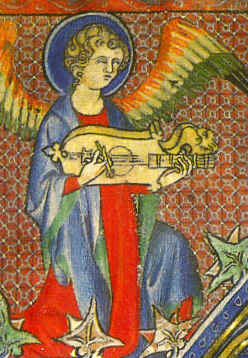Citole: Difference between revisions
From Cunnan
Jump to navigationJump to search
mNo edit summary |
(Image, link and rewording) |
||
| Line 1: | Line 1: | ||
[[image:Citole_Robert_De_Lisle_Psalter.jpg|right]] |
|||
The '''citole''' is a plucked, freted [[musical Instruments|musical instrument]] thought to have descended from the Greek kithara. It first appeared in Europe during the [[12th century]], and was widely used during the 13th and 14th centuries. |
The '''citole''' is a plucked, freted [[musical Instruments|musical instrument]] thought to have descended from the Greek kithara. It first appeared in Europe during the [[12th century]], and was widely used during the 13th and 14th centuries. |
||
The citole appeared in many forms, and was occasionally confused with a [[gittern]], but there are several features that seem to be common to most citoles |
The citole appeared in many forms, and was occasionally confused with a [[gittern]], but there are several features that seem to be common to most citoles such as a fretted neck and four courses. The strings are often depicted as being plucked by a long plectrum. |
||
==External Links== |
|||
* [http://crab.rutgers.edu/~pbutler/citole.html The Citole Project] |
|||
[[category:musical instruments]] |
|||
Latest revision as of 17:55, 12 February 2012
The citole is a plucked, freted musical instrument thought to have descended from the Greek kithara. It first appeared in Europe during the 12th century, and was widely used during the 13th and 14th centuries.
The citole appeared in many forms, and was occasionally confused with a gittern, but there are several features that seem to be common to most citoles such as a fretted neck and four courses. The strings are often depicted as being plucked by a long plectrum.
